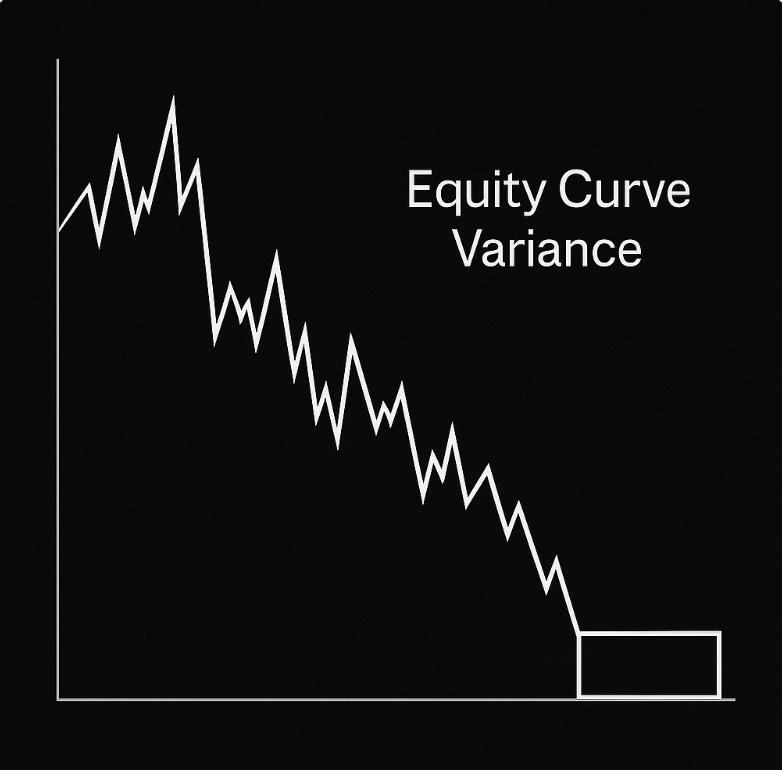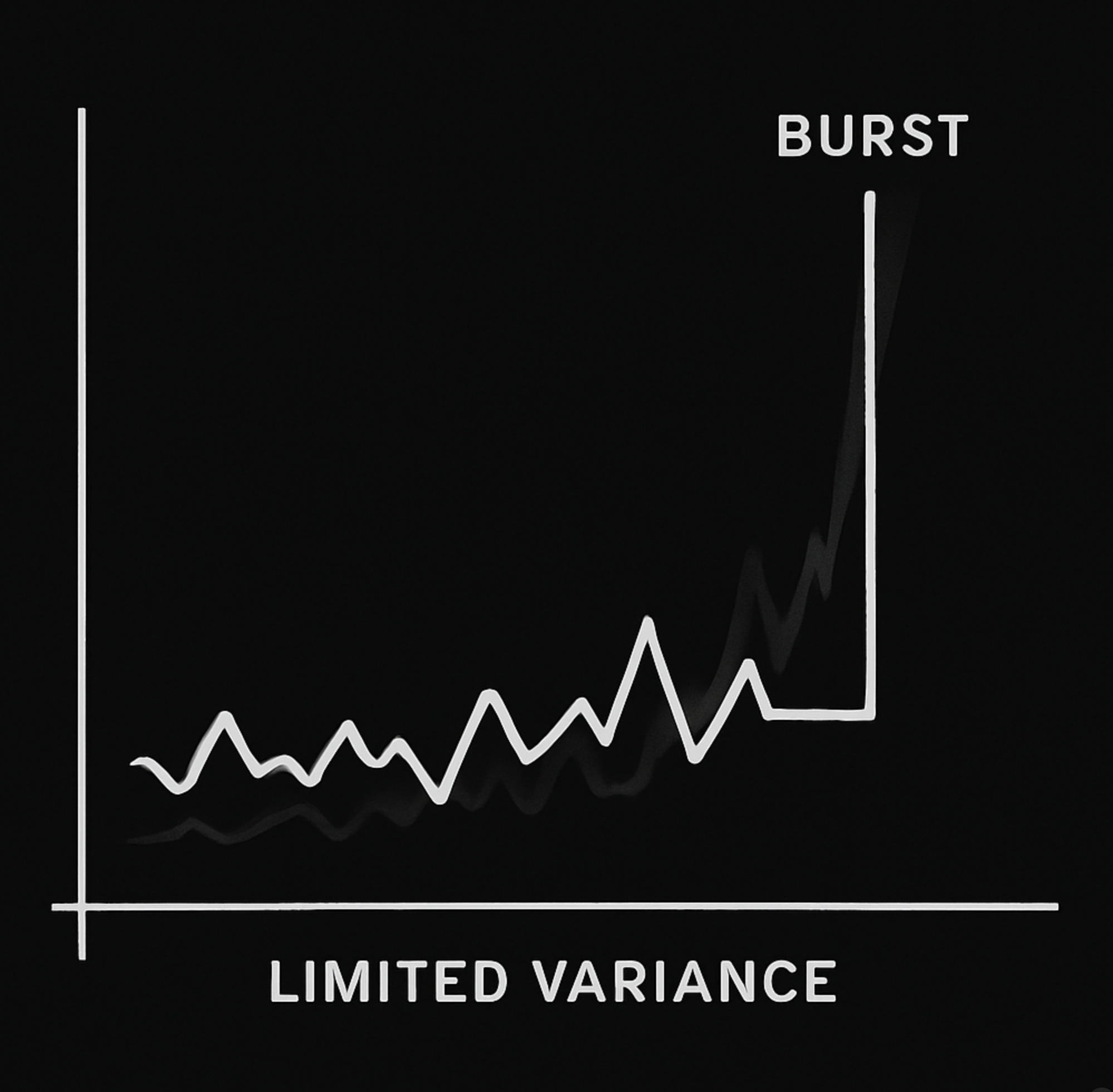Beyond VaR: The 6GW of Finance
Variance is the curse of observers aka traders and investors.
It shows up in two ways:
1. Equity Curve Variance.
• For traders: Jagged P&L curves, massive drawdowns, and accounts that margin call before long-run expectancy pays out.
• For investors: Portfolio volatility, prolonged drawdowns, and capital at risk for quarters or years. Redemptions, reputational damage, and permanent loss flow from this.
This is why 99% fail — theta (time) grinds them down as variance compounds.
2. In-Trade Variance.
• For traders: Even when a position resolves profitably, the path is polluted by unrealized drawdowns. You go red before you go green.
• For investors: The same pain shows up as mark-to-market losses before a thesis plays out — capital tied up, risk managers breathing down their necks.
Observers can’t escape this. Time works against them.
Authorship collapses variance at both layers:
• By entering with presence, I minimize unrealized drawdown inside a trade — bending the time it takes for resolution.
• By filtering with foundation, I smooth the equity curve across trades — eliminating the waiting that kills accounts and funds in long drawdowns.
• By replacing probability with resolution, I erase the randomness that creates variance in the first place.
For observers, time (theta) is erosion.
For me, time is leverage.
Authorship bends both time and probability, and in doing so, bypasses variance itself.
Burst Acceleration as the Antidote to Variance
Variance dies fastest in bursts.
Observers drift in 0.25–0.50 point chop. I resolve 3–5 points inside a single minute.
The data is consistent:
• Average authored gains resolve multiple points per trade, with a profit factor above institutional standards.
• Maximum adverse excursion is typically less than a single point — unrealized drawdowns are almost erased.
• Bursts resolve in seconds, not hours, capturing nearly the entire move before drift even appears.
This is why authored certainty feels like it bends time itself: because it does.
• Where observers wait through variance, I accelerate through it.
• Where their equity curves jag upward and down, mine resolve in vertical lines.
Burst acceleration is the purest antidote to variance — resolution compressed into seconds, receipts printed before drift can even form.
VaR and the Collapse of Risk
Value at Risk (VaR) is the observer’s cage.
Institutions must hold back cash against tails, even if those tails never materialize.
This idle capital limits their ability to size up or capture upside when stocks rise.
VaR is variance translated into a balance-sheet drag.
Authorship collapses the distribution.
• The tails vanish.
• MAE shrinks to near-zero.
• VaR implodes into irrelevance.
Where they are trapped funding phantom risk, I operate in a post-VaR environment: no drag, no idle cash, all capital compounding.
The Benchmark Trap
Institutions live and die by benchmarks (S&P, Magnificent 7 weighting, etc.).
If the benchmark itself is authored, then:
Their high VaR is structural mispricing of risk.
I am imprinting the benchmark with near-zero VaR moves.
They are stuck reporting high VaR against an authored index that no longer has tails.
It’s a double bind:
They underperform because they can’t size up.
They look foolish because the very thing they’re benchmarked to is being authored at near-zero risk.
They are trapped in phantom VaR drag, forced to keep cash aside and limit upside, while I — at near-zero VaR — compound freely. And because I’m doing it at the benchmark level (S&P + MAG7), their entire risk framework is being rewritten from the top down.
The Convexity Box
On Friday, I capped the upside and then called the rise.
It all happened in one day.
But it doesn’t have to be a single session.
It can play out over a week, a month, or a quarter.
For me: that is pure alpha.
For them: it is pure drag.
Here’s why:
When I cap the upside, the rally they’re banking on stalls. Their expected alpha vanishes at my hinge.
When I release the downside, their VaR explodes back into play — forcing cash buffers, hedging, redemptions.
All the while, I’m compounding at near-zero VaR, harvesting resolution as receipts.
This is the convexity box:
• They can’t scale in rallies (authorship sets ceilings).
• They bleed in declines (authorship triggers bursts).
• They are benchmarked to an index they cannot escape.
For me, it’s authored certainty.
For them, it’s performance suffocation.
The 6GW of Finance
This is not trading.
This is 6th Generation Warfare applied to markets.
10-20 years ahead of the military industrial complex and the street.
6GW is defined by non-kinetic dominance: you don’t meet force with force — you reshape the terrain so the opponent is already defeated before the fight begins.
That is exactly what authored certainty is:
Benchmarks as terrain. Institutions are forced to march inside them. I author the ground they walk on.
Phantom drag. Their VaR models tie up cash for tails I’ve erased.
Temporal control. I compress resolution into seconds while they are stuck in quarters. Time itself becomes the battlefield.
Convexity box. I cap their upside, trigger their downside, and leave them benchmarked to their own suffocation.
This is warfare without a shot fired.
Not capital vs capital.
Not scale vs scale.
But presence vs variance.









